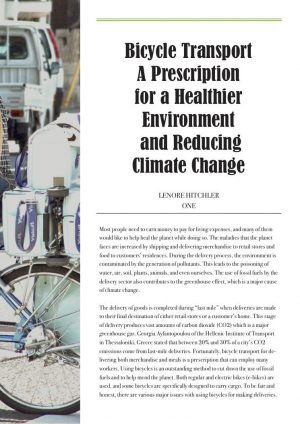 Most people need to earn money to pay for living expenses, and many of them would like to help heal the planet while doing so. The maladies that the planet faces are increased by shipping and delivering merchandise to retail stores and food to customers’ residences. During the delivery process, the environment is contaminated by the generation of pollutants. This leads to the poisoning of water, air, soil, plants, animals, and even ourselves. The use of fossil fuels by the delivery sector also contributes to the greenhouse effect, which is a major cause of climate change.
Most people need to earn money to pay for living expenses, and many of them would like to help heal the planet while doing so. The maladies that the planet faces are increased by shipping and delivering merchandise to retail stores and food to customers’ residences. During the delivery process, the environment is contaminated by the generation of pollutants. This leads to the poisoning of water, air, soil, plants, animals, and even ourselves. The use of fossil fuels by the delivery sector also contributes to the greenhouse effect, which is a major cause of climate change.
The delivery of goods is completed during “last mile” when deliveries are made to their final destination of either retail stores or a customer’s home. This stage of delivery produces vast amounts of carbon dioxide (CO2) which is a major greenhouse gas. Georgia Ayfantopoulou of the Hellenic Institute of Transport in Thessaloniki, Greece stated that between 20% and 30% of a city’s CO2 emissions come from last-mile deliveries. Fortunately, bicycle transport for delivering both merchandise and meals is a prescription that can employ many workers. Using bicycles is an outstanding method to cut down the use of fossil fuels and to help mend the planet. Both regular and electric bikes (e-bikes) are used, and some bicycles are specifically designed to carry cargo. To be fair and honest, there are various major issues with using bicycles for making deliveries. These concerns, such as whether or not they can make as many deliveries as vans, and the amount of goods that can be potentially handled by cargo bikes, were addressed by the ITF. The ITF is an abbreviation of The International Transport Forum which is part of the OECD, the Organisation for Economic Co-Operation and Development. The ITF stated that “logistics companies report that they can make as much as 25% more deliveries in a day than a van.” Jos Sluijsmans, from the International Cargo Bike Festival, stated that “50% of goods transported in cities can be moved by cargo bikes.”
Also, bicycle delivery is not practical in rural areas. However, according to the United States Census, 80% of the population resides in urban areas. Even though motor vehicles can potentially go faster than bicycles, urban traffic is relatively slow. The National Association of City Transportation Officials even advises a speed limit of 25 miles per hour (mph) on major streets in urban areas. According to Time, some models of electric bicycles can get 20 miles per hour (mph), whereas some can get 28 mph. Thus, the speed of e-bikes in urban areas is comparable to motor vehicles.
Another difficulty with using bicycles for cargo delivery is that some merchandise is just too heavy. However, many deliveries are small, and cargo bicycles can be designed to hold a significant load. The ITF reported that cargo bikes can carry up to approximately 1,000 pounds.
Further difficulties with cargo bicycle transport include the side effects facing cyclists, especially their poor working conditions. Current wages are inadequate to pay for a decent standard of living, especially considering the high price of apartments in the United States. Families with cyclists as their means of support live close to the official poverty level. Also, employee benefits are usually not provided, such as paid sick and vacation days in addition to health insurance. When cyclists are considered independent contractors, they must pay approximately 12.4% of their income into social security, and they don’t get Workman’s Compensation.
Also, weather conditions such as high winds, icy roads, and extreme hot and cold temperatures can be hazardous for cyclists. Weather conditions for cyclists are not the only conditions that can make delivery cyclists uncomfortable. If bicycles are ridden full-time every day, it is exhausting for most people. Both pedaling and maintaining the proper riding posture during a full day’s work expends a lot of energy.
Besides the uncomfortable conditions that delivery cyclists face on a day-to-day basis, there are questions about the long-term health effects of full-time bicycle use. Are cyclists going to have painful feet, ankles, legs, and arms in the future? Can their backs withstand riding on a bike all day? Are they going to develop tendonitis and arthritis? Since full-time cycling is so new, these questions are yet to be answered.
Thus, there are physical and financial liabilities of making bicycle delivery a full-time career. However, working as a bicycle delivery person might be a good option for those who need part-time employment, such as students. They can combine the necessity of earning money with their need for exercise.
Even though individual cyclists might not fare too well, cargo bicycling is extremely economical for businesses. Using delivery vans for the last mile is very expensive. The Onfleet, Inc. website reported that “last mile delivery costs account for 53% of the total cost of shipping.” In contrast, the ITF reported that replacing two mini trucks in Bogota with three cargo bikes lowered delivery costs by 16%.
In addition to the benefits of using cargo bicycles for businesses, they are great for the environment. Using bicycles produces fewer pollutants and greenhouse gases than delivery vans. The Zedify website in the United Kingdom published a study entitled “Potential for e-cargo bikes to reduce congestion and pollution from vans in cities.”
The report found that in 2016, vans produced 33% of NOx emissions from road transport in the UK. NOx are nitrogen oxides formed in engines during combustion processes and are found in both smog and acid rain. NOx acts as an indirect greenhouse gas by producing ozone, a greenhouse gas, during photochemical processes in the atmosphere. The report went on to state that “Looking just at tailpipe emissions from road transport (i.e. excluding tyre and brake wear and road abrasion), vans accounted for 31% of particulates (both PM10 and PM2.5) in 2016. … Replacing vans with (e-) cargo bikes disproportionately improves air quality and reduces emissions of greenhouse gases. Vans in the parcel and delivery sector may each emit more than 10 tonnes of CO2 per year. Trials by DHL [a logistics company that specializes in international shipping], where two vans are replaced by a ‘City Hub’ and four e-cargo bikes, are estimated to reduce CO2 by 16 tonnes pa. [per year].”
The report went on to state that “Per mile traveled, vans emit more carbon dioxide than cars. According to DBEIS, [Department for Business and Industrial Strategy] in 2018, average van emissions were 262gCO2e/km compared to 154gCO2e/km for a petrol car. Collectively van emissions accounted for 17% of greenhouse gas emissions from road transport (19mtCO2e) in 2016.”
Other sources confirm that using cargo bikes reduces CO2 emissions and thus are a better environmental choice than delivery vans. The ITF reported that “According to a variety of studies including one by the UK Department of Transport, commercial deliveries by vans contribute a disproportionate amount of pollution, about 30% of all transport emissions and over 50% of nitrogen oxide. [Various sources provide different statistics. However, the point is that vans produce a lot of greenhouse gas.] … A study by the University of Westminster estimated an e-cargo bike emits 90% less carbon dioxide than a van.”
A study conducted in Paris estimated that “cargo bike trips reduce the emissions generated by transporting one ton of goods over one kilometer [0.62 miles] by approximately 99% for vans and trucks.” Another Paris study found that “the eleven-fold increase in the volume of goods delivered by bike between 2001 and 2014 led to reductions of 45% and 50% in local air pollution and congestion from freight traffic, respectively.”
Additional evidence showing that bicycles produce less CO2 than vans was reported by the New York City Department of Transportation. It found that “20 cargo bike miles per day replace 20 van or box truck miles resulting in a per bike CO2 savings of approximately 7 tons per year.” Considering that 7 tons of CO2 is produced from only 20 van miles, the total amount of CO2 produced by all vans is enormous.
Another delivery process that produces vast amounts of CO2 is food delivery. It is an expanding service in the United States and various cities throughout the globe. The Fundera website reported that in 2021 “60% of American consumers order takeout or delivery at least once a week. … More than 112 million Americans say they’ve used a food delivery service. [Various other sources provide different statistics on this. For example, Mike Peregudov, co-founder of Whizz, a company that rents e-bikes, stated that “close to 200 million Americans order takeout at least once per week.”]
Using motor vehicles for individual food delivery produces large amounts of greenhouse gases. USwitch is a United Kingdom price comparison service. They estimated that the carbon footprint of households that spend around $63 per week on food delivery services is 450% higher than average than those that don’t.
In the United States alone, vast amounts of greenhouse gases are produced by over a million food deliverers using motor vehicles. According to the Business of Apps website, Doordash has a total of around one million people who deliver meals. Grubhub has around 65,000. Instacart has over 600,000 people who pick up items from stores and deliver them to customers.
Besides the high cost to the environment, motorized food delivery does not pay well. According to the Roadwarrior website, the average hourly pay for a Grubhub driver in the US, as of March 2024, was $18.75 with wages ranging from $9.86 to $39.77. As of May 2024, the average hourly pay in the US for Uber Eats was also $18.75. Since these are average figures, many drivers earn less than these amounts.
Fortunately, using bicycles is a better financial option for those who deliver food. Bicycles are cheaper to purchase than motor vehicles. Additionally, there are savings in fuel costs, vehicle maintenance, and expensive repairs resulting in cyclists having a larger income than motor vehicle drivers. Thus, using bicycles increases the take-home income of food deliverers as well as producing less greenhouse gases.
Switching from the big picture of the pros and cons of bicycle cargo delivery in general to one specific operation is relevant.
Trevor Roark is an entrepreneur who owns and operates Curbwise LLC. Curbwise LLC is a bicycle-powered delivery and distribution company based in Stevens Point, Wisconsin serving the surrounding area. Trevor’s customers include many local businesses, nonprofits, and local governments. According to Trevor’s website, “At the core of Curbwise is the triple bottom line approach (People, Planet, then Profit). Whether a business/organization/farm is looking to invest in local people power, reduce their carbon footprint (fossil-fuel-free delivery), and/or sustain a more localized economy, our delivery/distribution service will happily crank it out.”
Trevor replied to several questions. He stated “I have learned that the subsidization of fossil fuels has made my job (and maintaining my business) difficult, as well as employing pilots [cyclists who work for Trevor]. Basically, since the subsidies have deflated the cost of fuel, it’s very difficult to keep the cost of my services low enough to be competitive with other delivery/distribution services.”
He added that “The most typical model of delivery we’ve seen in the U.S. is gig work [gig workers are independent contractors or freelancers with temporary jobs in the service sector] for the likes of DoorDash, GrubHub, EatStreet, Uber Eats, etc. I don’t know all of the details, but gig work allows CEOs of these companies to pay less and provide less. Case in point, the CEO of DoorDash has a net worth of $2.1 billion, according to Forbes (real-time net worth). One cannot accumulate that much money and pay employees or 1099s (gig workers) a living wage with benefits.”
One of Trevor’s customers is Siren Shrub, which is a local company that makes specialty vinegar products. One of the owners stated “We are always exploring ways to reduce our environmental impact and support local initiatives. Collaborations with businesses like Curbwise not only help us achieve these goals but also inspire our community to consider greener alternatives in their daily lives.”
A customer who directly hires Trevor for personal deliveries stated “I want a community with less cars on the road, more bikes and more pedestrians. … How much safer is it for my daughter to have Trevor on his bike delivering goods than a car-based delivery rushing from house to house to try and make enough to break even.”
Thus, using bicycles during the last mile delivery stage is great for the financial bottom line in addition to protecting both the health of the populace and the environment.
Bicycle transport cuts down on both greenhouse gases and particulate matter, which is extremely damaging to human health. However, full-time bicycle riding takes its toll on cyclists, and it is difficult to make a decent living making bike deliveries. Thus, cyclists pay the price to protect the environment and fight climate change, while everyone else benefits from their labor. Fortunately, it is possible to improve working conditions for cargo cyclists. Then, cyclists, businesses, and the environment will all benefit from using cargo bicycles for last mile deliveries.
Lenore Hitchler


